-
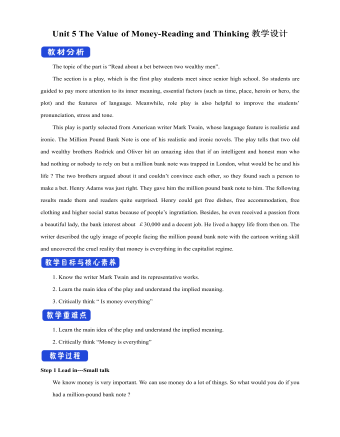
新人教版高中英语必修3Unit 5 The Value of Money-Reading and Thinking教学设计一
Everybody wants to get wealth.In today’s material world,making money or becoming wealthy symbolizes a person’s success and capability. Many people just make every effort, pay any price to attain greater wealth. With money,they can buy nice, large apartments in nice neighborhood. With money they can own luxurious cars. Wealth seems to bring all happiness in life.But is wealth the only road to happiness? Not really. There are many things in the world, which are beyond the means of money, such as friendship, love, health and knowledge. People are so preoccupied with struggling for money that they have no time or would not take the time to form or maintain friendship. What happiness can they feel living as lonely miserable creatures without love or friends in the world even if they accumulate tremendous wealth?In my opinion, people can’t do anything without money, but money is not everything. What money will bring you depends on your personal belief and goal in life. If you are kind enough to help others, especially the poor, money is a good thing to you. With it, you can do much more for the benefit of people and your country, and it will add to your own happiness. If you want money just for your own needs, you’ll never be satisfied or happy. In a word,you should have money spent for more people. Only then can money be the source of your happiness.Step 8 Homework4 students in a group, one acts Roderick, one Oliver, one servant and the fourth one acts Henry Adams, then listen to the tape, pay more attention to the difference between American English and British English in pronunciation, stress, tone.

新人教版高中英语必修3Unit 5 the value of money-Reading For Writing教学设计一
【参考范文】Narrator:(Henry is smiling as he leaves the restaurant. As he is walking down the street, he sees a sign for a place that cuts hair. He decides to get it cut. )H=Henry;B=Barber;R=rude manH:Good afternoon, I'd like to get a cut, if I may. (The barber looks at Henry's hair and continues cutting another man's hair. )Er, I'd really like a haircut. As you can see it's much too long. B:(in a rude manner) Yes, I can see that. Indeed, I can. H:Fine, well I'll have a seat then. (He sits in one of the barber's chairs. The barber turns to look at Henry. )B:It's quite expensive here, you know!Are you sure you can afford it?H:Yes. I think so. (In comes the rude man. )R:Hey you there. I need a haircut quickly. Can you do me straightaway?B:All right, then, get in the chair and I'll see what I can do. R:Thank you. (sits down in one of the barber's chairs)H:Excuse me, but I was here first. Aren't you going to do my hair first?B:This man's in a hurry. H:Well so am I!I insist that you cut my hair first. B:OK, but I'll have to be quick. This gentleman is waiting. H:Thank you. (They both become quiet. After his hair is cut, the barber tells Henry how much he must pay. Henry shows the barber the bank note. )B:Why, Mr . . . (looks shocked)H:Adams. Henry Adams. I'm sorry, I don't have any change. R:You're that Mr Adams! Well,I'm glad I waited or I might never have known it was you. B:Why, Mr Adams, please don't worry!(wearing a big smile) Nothing to worry about!Nothing at all!Please come back any time, even if you only need too little hairs cut!It will be my honour to serve you!

新人教版高中英语选修2Unit 4 Journey Across a Vast Land教学设计
当孩子们由父母陪同时,他们才被允许进入这个运动场。3.过去分词(短语)作状语时的几种特殊情况(1)过去分词(短语)在句中作时间、条件、原因、让步状语时,相当于对应的时间、条件、原因及让步状语从句。Seen from the top of the mountain (=When it is seen from the top of the mountain), the whole town looks more beautiful.从山顶上看,整个城市看起来更美了。Given ten more minutes (=If we are given ten more minutes), we will finish the work perfectly.如果多给十分钟,我们会完美地完成这项工作。Greatly touched by his words (=Because she was greatly touched by his words), she was full of tears.由于被他的话深深地感动,她满眼泪花。Warned of the storm (=Though they were warned of the storm), the farmers were still working on the farm.尽管被警告了风暴的到来,但农民们仍在农场干活。(2)过去分词(短语)在句中作伴随、方式等状语时,可改为句子的并列谓语或改为并列分句。The teacher came into the room, followed by two students (=and was followed by two students).后面跟着两个学生,老师走进了房间。He spent the whole afternoon, accompanied by his mom(=and was accompanied by his mom).他由母亲陪着度过了一整个下午。

新人教版高中英语选修2Unit 1 Science and Scientists-Reading and thinking教学设计
Step 5: After learning the text, discuss with your peers about the following questions:1.John Snow believed Idea 2 was right. How did he finally prove it?2. Do you think John Snow would have solved this problem without the map?3. Cholera is a 19th century disease. What disease do you think is similar to cholera today?SARS and Covid-19 because they are both deadly and fatally infectious, have an unknown cause and need serious public health care to solve them urgently.keys:1. John Snow finally proved his idea because he found an outbreak that was clearly related to cholera, collected information and was able to tie cases outside the area to the polluted water.2. No. The map helped John Snow organize his ideas. He was able to identify those households that had had many deaths and check their water-drinking habits. He identified those houses that had had no deaths and surveyed their drinking habits. The evidence clearly pointed to the polluted water being the cause.3. SARS and Covid-19 because they are both deadly and fatally infectious, have an unknown cause and need serious public health care to solve them urgently.Step 6: Consolidate what you have learned by filling in the blanks:John Snow was a well-known _1___ in London in the _2__ century. He wanted to find the _3_____ of cholera in order to help people ___4_____ it. In 1854 when a cholera __5__ London, he began to gather information. He ___6__ on a map ___7___ all the dead people had lived and he found that many people who had ___8____ (drink) the dirty water from the __9____ died. So he decided that the polluted water ___10____ cholera. He suggested that the ___11__ of all water supplies should be _12______ and new methods of dealing with ____13___ water be found. Finally, “King Cholera” was __14_____.Keys: 1. doctor 2. 19th 3.cause 4.infected with 5.hit 6.marked 7.where 8.drunk 9.pump 10.carried 11.source 12.examined 13.polluted 14.defeatedHomework: Retell the text after class and preview its language points

新人教版高中英语选修2Unit 2 Bridging Cultures-Discovering useful structures教学设计
The grammar of this unit is designed to review noun clauses. Sentences that use nouns in a sentence are called noun clauses. Nominal clauses can act as subject, object, predicate, appositive and other components in compound sentences. According to the above-mentioned different grammatical functions, nominal clauses are divided into subject clause, object clause, predicate clause and appositive clause. In this unit, we will review the three kinds of nominal clauses. Appositive clauses are not required to be mastered in the optional compulsory stage, so they are not involved.1. Guide the students to judge the compound sentences and determine the composition of the clauses in the sentence.2. Instruct students to try to learn grammar by generalizing grammar rules, controlling written practice, and semi-open oral output.3. Inspire the students to systematize the function and usage of noun clause1.Instruct students to try to learn grammar by generalizing grammar rules, controlling written practice, and semi-open oral output.2.Inspire the students to systematize the function and usage of noun clauseStep1: The teacher ask studetns to find out more nominal clauses from the reading passage and udnerline the nominal clauses.

新人教版高中英语选修2Unit 3 Food and Culture-Reading and thinking教学设计
The discourse explores the link between food and culture from a foreign’s perspective and it records some authentic Chinese food and illustrates the cultural meaning, gerography features and historic tradition that the food reflects. It is aimed to lead students to understand and think about the connection between food and culture. While teaching, the teacher should instruct students to find out the writing order and the writer’s experieces and feelings towards Chinese food and culture.1.Guide the students to read the text, sort out the information and dig out the topic.2.Understand the cultural connotation, regional characteristics and historical tradition of Chinese cuisine3.Understand and explore the relationship between food and people's personality4.Guide the students to use the cohesive words in the text5.Lead students to accurately grasp the real meaning of the information and improve the overall understanding ability by understanding the implied meaning behind the text.1. Enable the Ss to understand the structure and the writing style of the passage well.2. Lead the Ss to understand and think further about the connection between food and geography and local character traits.Step1: Prediction before reading. Before you read, look at the title, and the picture. What do you think this article is about?keys:It is about various culture and cuisine about a place or some countries.

新人教版高中英语选修2Unit 5 First Aid-Discovering useful structures教学设计
You have no excuse for not going.你没有理由不去。He was punished for not having finished his homework.他因未完成作业而受到惩罚。2.动词ing形式复合结构由物主代词或人称代词宾格、名词所有格或普通格加动词ing,即“sb./sb.'s+doing”构成。动词ing形式的复合结构实际上是给动词ing形式加了一个逻辑主语。动词ing形式的复合结构有四种形式:①形容词性物主代词+动词ing②名词所有格+动词ing③代词宾格+动词ing④名词+动词ingHer coming to help encouraged all of us.她来帮忙鼓舞了我们所有人。The baby was made awake by the door suddenly shutting.这个婴儿被突然的关门声吵醒了。Can you imagine him/Jack cooking at home?你能想象他/杰克在家做饭的样子吗?无生命名词无论是作主语还是作宾语都不能用第②种形式。Tom's winning first prize last year impressed me a lot.汤姆去年得了一等奖使我印象深刻。Do you mind my/me/Jack's/Jack leaving now?你介意我/杰克现在离开吗?Excuse me for my not coming on time.很抱歉我没能按时来。His father's being ill made him worried.他父亲病了,他很担心。We are looking forward to the singer's/the singer to give us a concert.我们盼望着这位歌手来给我们举办一场演唱会。
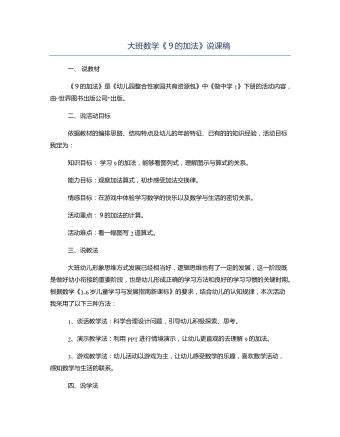
大班数学《9的加法》说课稿
大班幼儿形象思维方式发展已经相当好,逻辑思维也有了一定的发展,这一阶段既是做好幼小衔接的重要阶段,也是幼儿形成正确的学习方法和良好的学习习惯的关键时期。根据数学《3-6岁儿童学习与发展指南新课标》的要求,结合幼儿的认知规律,本次活动我采用了以下三种方法:1、谈话教学法:科学合理设计问题,引导幼儿积极探索、思考。2、演示教学法:利用PPT进行情境演示,让幼儿更直观的去理解9的加法。3、游戏教学法:幼儿活动以游戏为主,让幼儿感受数学的乐趣,喜欢数学活动,感知数学与生活的联系。
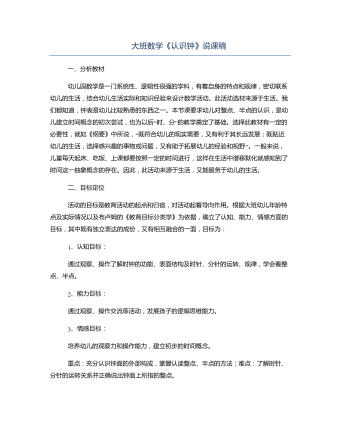
大班数学《认识钟》说课稿
幼儿园数学是一门系统性、逻辑性很强的学科,有着自身的特点和规律,密切联系幼儿的生活,结合幼儿生活实际和知识经验来设计数学活动。此活动选材来源于生活。我们都知道,钟表是幼儿比较熟悉的东西之一。本节课要求幼儿对整点、半点的认识,是幼儿建立时间概念的初次尝试,也为以后“时、分”的教学奠定了基础。选择此教材有一定的必要性,就如《纲要》中所说,“既符合幼儿的现实需要,又有利于其长远发展;既贴近幼儿的生活,选择感兴趣的事物或问题,又有助于拓展幼儿的经验和视野”。一般来说,儿童每天起床、吃饭、上课都要按照一定的时间进行,这样在生活中潜移默化就感知到了时间这一抽象概念的存在。因此,此活动来源于生活,又能服务于幼儿的生活。
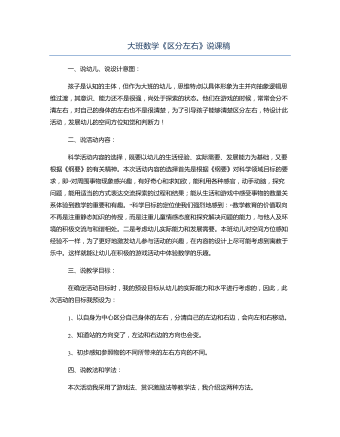
大班数学《区分左右》说课稿
科学活动内容的选择,既要以幼儿的生活经验、实际需要、发展能力为基础,又要根据《纲要》的有关精神。本次活动内容的选择首先是根据《纲要》对科学领域目标的要求,即“对周围事物现象感兴趣,有好奇心和求知欲,能利用各种感官,动手动脑,探究问题,能用适当的方式表达交流探索的过程和结果;能从生活和游戏中感受事物的数量关系体验到数学的重要和有趣。”科学目标的定位使我们强烈地感到:“数学教育的价值取向不再是注重静态知识的传授,而是注重儿童情感态度和探究解决问题的能力,与他人及环境的积极交流与和谐相处。二是考虑幼儿实际能力和发展需要。本班幼儿对空间方位感知经验不一样,为了更好地激发幼儿参与活动的兴趣,在内容的设计上尽可能考虑到寓教于乐中。这样就能让幼儿在积极的游戏活动中体验数学的乐趣。
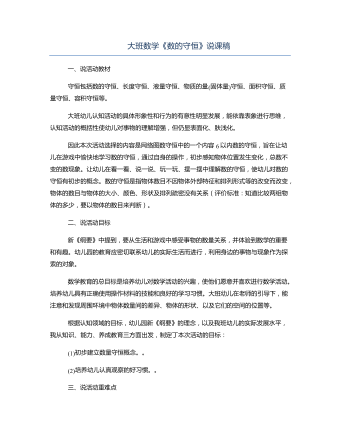
大班数学《数的守恒》说课稿
守恒包括数的守恒、长度守恒、液量守恒、物质的量(固体量)守恒、面积守恒、质量守恒、容积守恒等。大班幼儿认知活动的具体形象性和行为的有意性明显发展,能依靠表象进行思维,认知活动的概括性使幼儿对事物的理解增强,但仍显表面化、肤浅化。因此本次活动选择的内容是网络图数守恒中的一个内容6以内数的守恒,旨在让幼儿在游戏中愉快地学习数的守恒,通过自身的操作,初步感知物体位置发生变化,总数不变的数现象。让幼儿在看一看、说一说、玩一玩、摆一摆中理解数的守恒,使幼儿对数的守恒有初步的概念。数的守恒是指物体数目不因物体外部特征和排列形式等的改变而改变,物体的数目与物体的大小、颜色、形状及排列疏密没有关系(评价标准:知道比较两组物体的多少,要以物体的数目来判断)。

大班数学《对号入座》说课稿
大班幼儿思维处于抽象逻辑的萌芽发展阶段,在认识事物方面不仅能够感知事物的特点,而且能够进行初步的判断和推理。《幼儿园教育指导纲要》提出:数学教育必须要让幼儿能从生活和游戏中感受事物的数量关系并体验到学数学的重要性和趣味性,引导幼儿对周围环境中数量、形、时间和空间等现象产生兴趣,用简单的数学方法解决生活和游戏中出现的某些简单问题。由此可见,生活化、游戏化已经成为构建数学课程最基本的原则。该教材选自南方出版社《新课标》,教材取之于生活,发展能力运用于生活,这是幼儿园所有课程建构的出发点和归宿。为此我选择了本节活动,激发幼儿体验数学活动的兴趣,并在此基础上展开思考、探索,学会自觉地构建知识。
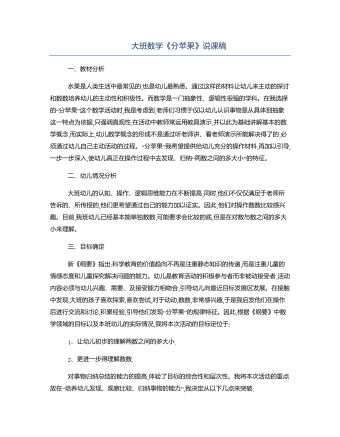
大班数学《分苹果》说课稿
水果是人类生活中最常见的,也是幼儿最熟悉。通过这样的材料让幼儿来主动的探讨和数数培养幼儿的主动性和积极性。而数学是一门抽象性、逻辑性很强的学科。在我选择的“分苹果”这个数学活动时,我是考虑到,老师们习惯于仅以幼儿认识事物是从具体到抽象这一特点为依据,只强调直观性,在活动中教师常运用教具演示,并以此为基础讲解基本的数学概念,而实际上,幼儿数学概念的形成不是通过听老师讲、看老师演示所能解决得了的,必须通过幼儿自己主动活动的过程。“分苹果”我希望提供给幼儿充分的操作材料,再加以引导,一步一步深入,使幼儿真正在操作过程中去发现、归纳“两数之间的多大小”的特征。
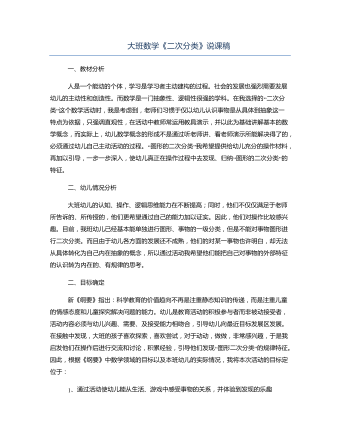
大班数学《二次分类》说课稿
人是一个能动的个体,学习是学习者主动建构的过程。社会的发展也强烈需要发展幼儿的主动性和创造性。而数学是一门抽象性、逻辑性很强的学科。在我选择的“二次分类”这个数学活动时,我是考虑到,老师们习惯于仅以幼儿认识事物是从具体到抽象这一特点为依据,只强调直观性,在活动中教师常运用教具演示,并以此为基础讲解基本的数学概念,而实际上,幼儿数学概念的形成不是通过听老师讲、看老师演示所能解决得了的,必须通过幼儿自己主动活动的过程。“图形的二次分类”我希望提供给幼儿充分的操作材料,再加以引导,一步一步深入,使幼儿真正在操作过程中去发现、归纳“图形的二次分类”的特征。
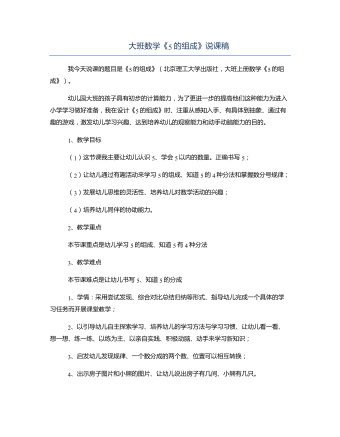
大班数学《5的组成》说课稿
我今天说课的题目是《5的组成》(北京理工大学出版社,大班上册数学《5的组成》)。幼儿园大班的孩子具有初步的计算能力,为了更进一步的提高他们这种能力为进入小学学习做好准备,我在设计《5的组成》时、注重从感知入手、有具体到抽象、通过有趣的游戏,激发幼儿学习兴趣、达到培养幼儿的观察能力和动手动脑能力的目的。1、教学目标(1)这节课我主要让幼儿认识5、学会5以内的数量。正确书写5;(2)让幼儿通过有趣活动来学习5的组成、知道5的4种分法和掌握数分号规律;(3)发展幼儿思维的灵活性、培养幼儿对数学活动的兴趣;(4)培养幼儿同伴的协助能力。
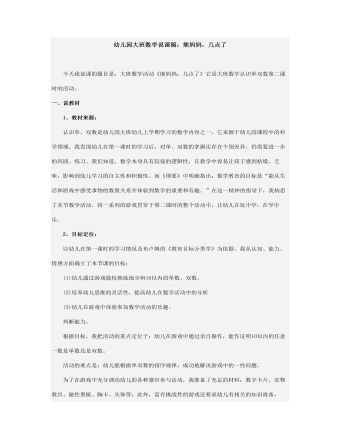
幼儿园大班数学说课稿
以幼儿在第一课时的学习情况及布卢姆的《教育目标分类学》为依据,我从认知、能力、情感方面确立了本节课的目标: (1)幼儿通过游戏能较熟练地分辩10以内的单数、双数。 (2)培养幼儿思维的灵活性,提高幼儿在数学活动中的分析 (3)幼儿在游戏中体验参加数学活动的乐趣。 判断能力。 根据目标,我把活动的重点定位于:幼儿在游戏中通过亲自操作,能作证明10以内的任意一数是单数还是双数。 活动的难点是:幼儿能根据单双数的排序规律,成功地解决游戏中的一些问题。 为了在游戏中充分调动幼儿的各种感官参与活动,我准备了充足的材料:数字卡片、实物教具、磁性黑板、胸卡、头饰等:此外,富有挑战性的游戏还要求幼儿有相关的知识准备,如:掌握序数、相邻数等。
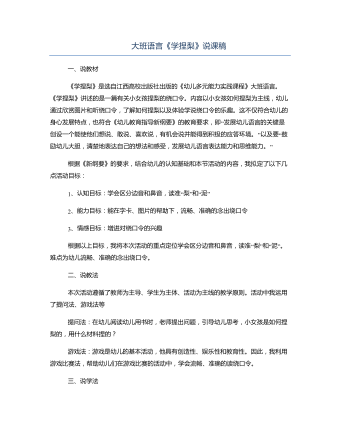
大班语言《学捏梨》说课稿
《学捏梨》是选自江西高校出版社出版的《幼儿多元能力实践课程》大班语言。《学捏梨》讲述的是一篇有关小女孩捏梨的绕口令。内容以小女孩如何捏梨为主线,幼儿通过欣赏图片和听绕口令,了解如何捏梨以及体验学说绕口令的乐趣。这不仅符合幼儿的身心发展特点,也符合《幼儿教育指导新纲要》的教育要求,即“发展幼儿语言的关键是创设一个能使他们想说、敢说、喜欢说,有机会说并能得到积极的应答环境。”以及要“鼓励幼儿大胆,清楚地表达自己的想法和感受,发展幼儿语言表达能力和思维能力。”根据《新纲要》的要求,结合幼儿的认知基础和本节活动的内容,我拟定了以下几点活动目标:1、认知目标:学会区分边音和鼻音,读准“梨”和“泥”2、能力目标:能在字卡、图片的帮助下,流畅、准确的念出绕口令3、情感目标:增进对绕口令的兴趣根据以上目标,我将本次活动的重点定位学会区分边音和鼻音,读准“梨”和“泥”。难点为幼儿流畅、准确的念出绕口令。
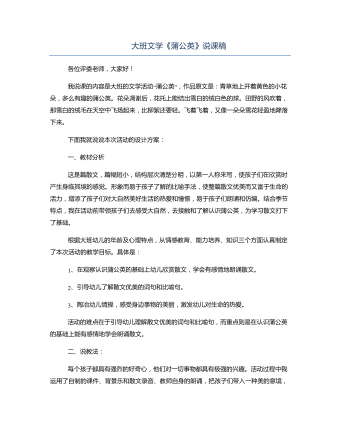
大班文学《蒲公英》说课稿
一、教材分析这是篇散文,篇幅短小,结构层次清楚分明,以第一人称来写,使孩子们在欣赏时产生身临其境的感觉。形象而易于孩子了解的比喻手法,使整篇散文优美而又富于生命的活力,增添了孩子们对大自然美好生活的热爱和憧憬,易于孩子们朗诵和仿编。结合季节特点,我在活动前带领孩子们去感受大自然,去接触和了解认识蒲公英,为学习散文打下了基础。根据大班幼儿的年龄及心理特点,从情感教育、能力培养、知识三个方面认真制定了本次活动的教学目标。具体是:1、在观察认识蒲公英的基础上幼儿欣赏散文,学会有感情地朗诵散文。2、引导幼儿了解散文优美的词句和比喻句。3、陶冶幼儿情操,感受身边事物的美丽,激发幼儿对生命的热爱。活动的难点在于引导幼儿理解散文优美的词句和比喻句,而重点则是在认识蒲公英的基础上能有感情地学会朗诵散文。二、说教法:每个孩子都具有强烈的好奇心,他们对一切事物都具有极强的兴趣。活动过程中我运用了自制的课件、背景乐和散文录音、教师自身的朗诵,把孩子们带入一种美的意境,使孩子们在优美的意境中感受了散文的语言美,体验学习散文的快乐。活动的开展由易到难,层层深入,使孩子们能主动积极、自愿地参与和学习,获得经验,体验了孩子的主体地位,也正好契合了《纲要》中关于“教师应成为幼儿学习活动的支持者、合作者、引导者”的理念。此外我还采用了欣赏倾听法、谈话交流法、游戏表演法引导孩子在活动中敢说、想说、愿意说,树立了孩子的自信心,从而使本次活动达到美的享受,快乐学习的和谐统一。
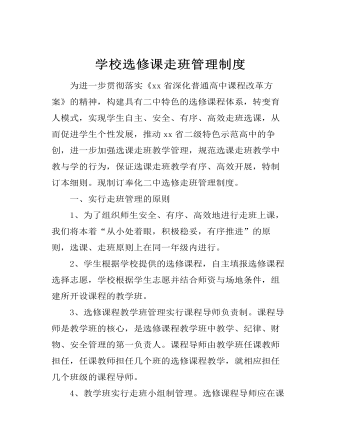
学校选修课走班管理制度
一、实行走班管理的原则 1、为了组织师生安全、有序、高效地进行走班上课,我们将本着“从小处着眼,积极稳妥,有序推进”的原则,选课、走班原则上在同一年级内进行。 2、学生根据学校提供的选修课程,自主填报选修课程选择志愿,学校根据学生志愿并结合师资与场地条件,组建所开设课程的教学班。 3、选修课程教学班管理实行课程导师负责制。课程导师是教学班的核心,是选修课程教学班中教学、纪律、财物、安全管理的第一负责人。课程导师由教学班任课教师担任,任课教师担任几个班的选修课程教学,就相应担任几个班级的课程导师。 4、教学班实行走班小组制管理。选修课程导师应在课程第一讲前,以原行政班为单位,将学生划分为几个走班学习小组,固定学生座位,确定教学班教学座位表,每次教学中学生座位不允许随意调换。
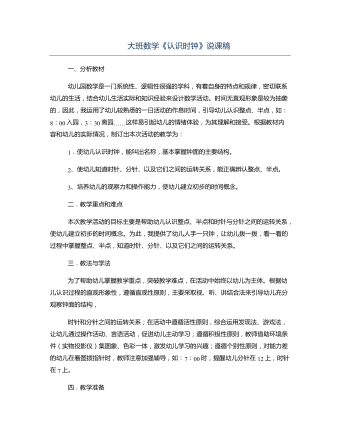
大班数学《认识时钟》说课稿
为了帮助幼儿掌握教学重点,突破教学难点,在活动中始终以幼儿为主体。根据幼儿认识过程的直观形象性,遵循直观性原则,主要采取视、听、讲结合法来引导幼儿充分观察钟面的结构,时针和分针之间的运转关系;在活动中遵循活性原则,综合运用发现法、游戏法,让幼儿通过操作活动、言语活动,促进幼儿主动学习;遵循积极性原则,教师借助环境条件(实物投影仪)集图象、色彩一体,激发幼儿学习的兴趣;遵循个别性原则,对能力差的幼儿在看图拨指针时,教师注意加强辅导,如:7:00时,提醒幼儿分针在12上,时针在7上。

